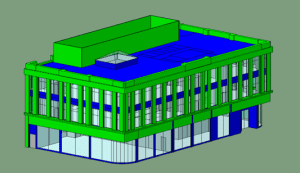The term Performance Gap has become a significant topic in the design community, and refers to the discrepancy between the predicted performance of a building, as designed and the actual performance once the building is in use. Understanding and addressing this Gap is essential to achieving the intended performance of buildings and meeting the broader environmental and operational goals.
What is Performance Gap in an operational building?
It is the shortfall in a building’s predicted energy performance compared to its real performance that can be evidenced during its operational phase. This could be attributed to the theoretical energy compliance targets set out in the UK Building Regulations, such as Part L or Section 6. These regulatory “compliance” calculations, such as those required under part L, are often incorrectly used within industry to be a predictor of total carbon emissions, rather than their correct purpose of assessing the “Regulated Carbon Emissions”
A recent study revealed that the post-occupancy energy demand exceeded the predicted values by 34%, with a standard deviation of 55%, for 64 non-domestic buildings. This further implies an increase in carbon emissions directly from the predicted values.
This Performance Gap isn’t just in the UK. A study of LEED (Leadership in Energy and Environmental Design) certified buildings in the United States found that the number of buildings that performed worse than expected was equal to the number that performed better. In fact, some of the high-performance buildings used more energy than the standard energy code requirement.
The Impact of Performance Gap
A narrow approach to building compliance leads to a Performance Gap when the building is set to operate. This will have countless adverse impacts on the overall performance of the building, including carbon emissions and operational expenditures, and potentially imply higher energy consumption.
This misalignment has been largely uncovered in the post-occupancy evaluation, which is credited to the increased interest in certification in high-performance buildings.
Multiple studies have shown that carbon emissions from buildings with Performance Gaps increase from the predicted emission range. A collective deviation of carbon emissions will alarmingly pull back the NetZero targets.
In such a case, the reduced carbon emissions or Low Zero facility will exist only as a theoretical statement, which will not be the actual case.
Reasons for Performance Gaps
The reasons for the Performance Gap include inadequate knowledge about the space occupancy and operational criteria, the skills required to generate an accurate model, poor design details, products and building envelope.
It is noted that in most cases, the reason for the Performance Gap is unregulated energy use, extra occupancy and operating hours, poor BMS control, and bad commissioning.
How can we reduce the Performance Gap?
Generating a building simulation model is key to reducing the Performance Gap. It could very well be used for a new building or an existing one. For an existing building, a digital twin model could be required.
A dynamic energy model enables the modeller to subject the building to multiple occupancy and operational conditions and analyse the most appropriate input data to bring the energy performance closer to reality.
Most importantly, the model must reflect the in-use performance and occupancy patterns that match the real operational phase. The model can also be used to test various expected changes in occupant behaviour and their impact on energy efficiency.
A digital twin of an existing building can be calibrated to match the actual energy usage, which will further help the designer analyse the reason for the Performance Gap.

Figure-2: IES VE model of a retrofit commercial building
Furthermore, this overall effort requires responsible coordination between all the stakeholders to understand the building’s operational pattern. An energy model should be simulated with all expected changes in key factors like heat gains, occupancy patterns, etc.
It is time for the industry to shift the focus from ‘Design for Compliance’ to ‘Design for Performance’, ensuring that we remain on track to achieve Net Zero 2050.
Ultimately this requires access to complex building and energy modelling software; as well as ensuring the modeller is highly skilled and experienced in developing, interrogating and analysing the model. The Net Zero UK team has the software, skills, knowledge and experience to deliver this service – ensuring that our clients’ buildings do not suffer from Performance Gaps and are truly on the journey to net zero.


